CLASS-10
CHAPTER-6 LIFE PROCESSES
CRITERIA TO DECIDE WHETHER SOMETHING IS ALIVE OR NOT?
The most important criteria to decide whether something is alive or not is movement. All the living things move without the help of any external help.
Some movements in our body are easily visible like movement of hand, legs, neck etc but some molecular movements are not visible easily visible. These molecular movements in cells and tissues are necessary for all life processes.
CHARACTERISTICS OF LIVING THINGS
- Living things can move by themselves.
- Living things need food, air and water.
- Living things can grow.
- Living things can respire.
- Living things can excrete.
- Living things can responds.
- Living things can reproduce.
MEANING OF LIFE PROCESSES
The basic functions performed by living organisms to maintain their life on this earth are called life processes.
The basic life processes are-
- Nutrition
- Respiration
- Transportation
- Excretion
- Growth and movements
- Controls and coordination.
NUTRITION
1. MEANING OF NUTRITION- Nutrition is a process of intake nutrients by an organism as well its utilization to obtain energy.
NOTE-Nutrients are the substances which an organisms obtain from its surrounding and uses it as a source of energy.
For Example– Carbohydrates, fats , proteins, vitamins etc.
MODES OF NUTRITION
Modes of nutrition can be classified as
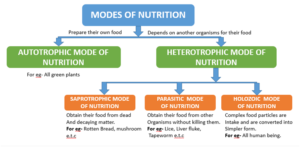
1. AUTOTROPHIC MODE OF NUTRITION
In autotrophic mode of nutrition Organisms make their own food by using simple inorganic materials like CO2 and water in the presence of sunlight.
For example– All green plants.
2. HETEROTROPHIC MODE OF NUTRITIONS
In heterotrophic mode of nutrition, Organisms do not make their own food, they depends on other organisms for their food.
All the animals, most of the bacterial, fungi and non-green plants have heterotrophic mode of nutrition.
TYPES OF HETEROTROPHIC MODE OF NUTRITIONS
There are three types of heterotrophic mode of nutrition.
(i) Saprotrophic mode of nutrition
(ii) Parasitic mode of nutrition
(iii) Holozoic mode of nutrition
(i)SAPROTROPHIC MODE OF NUTRITION
In this mode of nutrition organisms obtain their food from dead and decaying organic matter of plants and animals.
For example- Rotten bread mold, Mushroom, Yeast and many bacteria.
NOTE-Saprotrops break down the complex organic molecule into simpler substances outside the body using enzymes.
 ‘
‘
Rotten bread Mushroom Bacteria
(ii) PARACITIC MODE OF NUTRITIONS
In Parasitic mode of nutrition organisms obtain their food from the body of other organism without killing them.
For eg- Lice, Liver fluke, Tapeworm e.t.c
NOTE-
- The organism which obtain food is called
- The organism which provide food is called Host

(iii) HOLOZOIC MODE OF NUTRITIONS
In holozoic mode of nutrition, Organisms intake complex organic food by the process ingestion. The ingested food is digested and then absorbed in the body of organisms. Absorbed food is further assimilated and undigested food is thrown out of the body.
For example–Human being, cat , dog , amoeba, fish etc

STEPS OF HOLOZOIC MODE OF NUTRITION
The various steps for holozoic mode of nutrition are as follow
1. Ingestion: The process of taking food inside the body is called ingestion.
2. Digestion: In digestion the ingested food is converted into simple form with the help of digestive enzymes.
3. Absorption: In this stage the food digested in second step is absorbed into the cells of body. Absorption takes place in the small intestine.
4.Assimilation: Assimilation is the process of utilizing the food absorbed in third step by various cells of the body.
5. Egestion: Egestion is the final step of holozoic nutrition in which the undigested food is removed from the body.
HERBIVORES, CARNIVORES AND OMNIVORES ORGANISMS
The organisms having holozoic nutrition are further classified in three categories. These are Herbivores, Carnivores and Omnivores.
(A)HERBIVORES
The organisms which consume or eat only plants as their source of food are called herbivores. For example, cow, rabbit, goat, deer, locust and camel etc.
(B)CARNIVORES
The organisms which eat other animals or meat only are called carnivores. For example, lion, bear, snake, crocodile, lizard, eagle and wolf etc.
(C) OMNIVORES
The organisms which eat both plant food as well as meat of animals are called omnivores. The best examples of omnivores are human beings, crow, dog, sparrow and ants etc.

NUTRITION IN PLANTS
Plants make their own food by using simple inorganic materials like CO2 water in the presence of sunlight
![]()
CONDITIONS NECESSARY FOR PHOTOSYNTHESIS
The various conditions for photo synthesis are:-
(i) Carbon dioxide
(ii) Water
(iii) Sunlight
(iv) Chlorophyll

STEPS FOR PHOTOSYNTHESIS
The process photosynthesis takes place in the following steps:-
- Absorption of sunlight by the chlorophyll present in the leaves of plants.
- Conversion of light energy into chemical energy and splitting of water molecule into H2 and O2 by light energy.
- CO2 is reduced by water to form carbohydrates
NUTRITION IN AMOEBA
Amoeba is a unicellular animal living in water.Its mode of nutrition is Holozoic. The various steps involved in nutrition are-
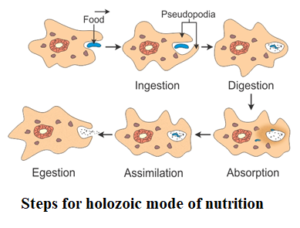
1. Ingestion- It intake its food by forming a finger like projection known as pseudopodia.
2. Digestion- Digestive enzymes react on the food present in the food vacuole and break it down into simple and soluble molecules.
3. Absorption- Energy is absorbed from the digested food.
4. Assimilation- Absorbed energy is then utilize for the growth and repair.
5. Egestion- The undigested food is then thrown out of the body by the process diffusion.
NUTRITION IN AMOEBA
Note-In amoeba, the process of obtaining food is called phagocytosis.
Q: How amoeba excrete?
Ans:Amoeba has no special organ to remove undigested parts of food. When some undigested food is collected in its body then its cell membrane suddenly gets rapture and undigested food is thrown out of the body by the process Diffusion.
Q: What substance enter into the food vacuole in amoeba to break down food?
Ans:The digestive enzymes from the cytoplasm enter into the food vacuole in amoeba to break down food ?
Q: How does paramecium obtain its food?
Paramecium is a unicellular animal living in water. Its mode of nutrition is Holozoic. The various steps involved in nutrition are-

1. Ingestion- It intake its food by using its hair like structure called cilia.
2. Digestion– Digestive enzymes react on the food present in the food vacuole and break it down into simple and soluble molecules.
3. Absorption– Energy is absorbed from the digested food.
4. Assimilation- Absorbed energy is then utilize for the growth and repair.
5. Egestion- The undigested food is then thrown out of the body by the process diffusion.
NUTRITION IN HUMAN BEING
Nutrition in human beings take place trough human digestive system. The digestive system consist of alimentary canal and glands which produce enzymes to break down food into smaller molecules. The main glands and organs of digestive system are as follow.
ORGANS :
1.Mouth
2. Oesophagus (food pipe)
3. Stomach
4. Small Intestine
5. Large Intestine
6. Anus
GLANDS:
1. Salivary Gland
2. Gastric Gland
3 Liver
4. Pancreas
5. Intestinal Gland
IMPORTANT ORGANS AND THEIR FUNCTIONS
 1. MOUTH: The human being have a special organ for the ingestion of food called mouth. Here food is slightly digested with the help of teeth and saliva.
1. MOUTH: The human being have a special organ for the ingestion of food called mouth. Here food is slightly digested with the help of teeth and saliva.
2. OESOPHAGUS(FOOD PIPE): It is a pipe like structure and is responsible to carry slightly digested food from mouth to stomach.
3.STOMACH: It is a J- shaped organ present on the left side of abdomen. In stomach, slightly digested food is further digested to form semi-solid paste.
4. SMALL INTESTINE: The small intestine is the main site of absorption of the digested food. The absorbed food is then mixed into the blood.
5. LARGE INTESTINE: The large intestine is responsible to carry undigested food from small intestine to anus.
6. ANUS: It is the excretory organ present in human body and is responsible to remove undigested food from our body.
IMPORTANT GLANDS AND THEIR FUNCTIONS
1. SALIVART GLAND: It is present in our mouth and secrete enzyme salivary amylase which digest the starch present in the food into Sugar.
2. GASTRIC GLAND: The gastric gland is present in the walls of stomach and secrete Gastric juice. The gastric juice consist of three substances.
- HYDROCHLORIC ACID: Hydrochloric acid makes the medium acidic and kills the bacteria.
- ENZYME PEPSIN: It help in the digestion of Protein by converting it into amino acid.
- MUCUS: Protect the wall of stomach from the action of hydrochloric acid secreted by gastric gland.
3.LIVER: The liver secrete Bile juice. Bile is alkaline in nature and contain salts which help to break the fats present in the food into fatty acids and Glycerol.
4. PANCREAS : This gland is present at the joint of stomach and small intestine. It secrete pancreatic juice which contains three digestive enzymes.
- PANCREATIC AMYLASE: It breaks starch into sugar.
- TRYPSIN:It helps in the digestion of protein by converting it into amino acid.
- LIPASE: It breaks fats into fatty acid and glycerol.
5. INTESTINAL GLANDS: The intestinal gland secretes intestinal juice. This intestinal juice contains number of enzymes which digest.
- Carbohydrates into glucose.
- Proteins into amino acid.
- Fats into fatty acids and glycerol.
Q: What is the other name of food pipe?
Ans: Esophagus
Q: What substance is mixed with food in the mouth during chewing by the teeth?
Ans: Saliva
Q: Where is the digested food absorbed in the human body?
Ans: Small Intestine
Q: Which part of body secrete bile? Where is bile secrete?
Ans: Bile is secreted by Liver and is stored in Gall Bladder.
Q: What are the functions of Hydrochloric acid in our stomach?
Ans: The hydrochloric acid (HCl) makes the medium acidic and kills the bacteria.
DENTAL CARIES
The formation of small cavities in the teeth due to the action of acid forming bacteria and improper dental care are called dental caries.
DENTAL PLAQUE
If the teeth are not cleaned regularly, they covered a sticky yellowish layer of food particles and bacteria cells called dental plaque.
STRUCTURE OF LEAF
The structure of leaf can be discussed as:-
(a)EXTERNAL STRUCTURE
The external structure of leaf consist of lamina, veins, mid-rib and petiole.
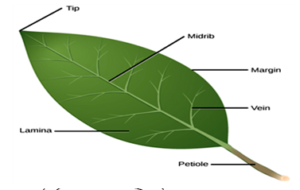
External Structure of leaf
(i)Lamina: It is a flat, thin and large surface area of the leaf. It is responsible for the absorption of the sunlight.
(ii) Vein: These are the vascular structures on the leaf which supply water throughout its surface.
(iii) Mid-rib: It is the mid line on the leaf which divide it into two equal parts.
(iv) Petiole: It is the stalk of the leaf it is responsible to attach the leaf to the stem.
(b)INTERNAL STRUCTURE
Internal structure of leaf consist of epidermis and stomata.
(i) EPIDERMIS-It is the uppermost layer of the leaf. It consist of two parts. They are upper epidermis and lower epidermis.
- Upper Epidermis- It is the single layer of transparent cells with no chlorophyll/ chloroplast known as cutile. It prevent excess loss of water during transpiration.
- Lower Epidermis–Lower Epidermis consist of stomata and help in the exchange of gases.
(ii)STOMATA

Structure of stomata
- The tiny pores present on the leaves through which exchange of gases takes place. Each stomata has a pair of guard cell which control opening and closing of stomatal pores.
- When water enters into the cells, it swells and the pores open.
- When the guard cells lose water, it shrinks and the pores closes.
FUNCTIONS OF STOMATA
There are two main functions of stomata. They are
(i) Exchange of gases
(ii) Loss of excess water through transpiration.
Q: Write an activity to show that sunlight is necessary for photosynthesis.
Ans: Activity
- Take a potted plant with green leaves.
- Place it in dark room to remove starch present in the leaves.
- Take a thin strip of aluminium and wrap it in the centre of the leaf on both sides so that sunlight may not fall on covered part of the leaf.
- Keep the plant in sunshine about three to four hour.
- Pluck the leaf and boil it with alcohol to remove green colour chlorophyll.
- Now pour some iodine solution over the leaf and observe the change in the colour of the leaf.
OBSERVATIONS
- The covered part of the leaf do not turns to blue-black showing no starch is present in the middle part of the plant.
- The uncovered part of the leaf turns to blue- black showing starch is present in the uncovered part.
The above activity shows that sunlight is necessary for photosynthesis.
Q: Why is leaf boiled in alcohol before iodine test?
Ans: We boil the leaf in alcohol to remove the chlorophyll present in it so that it could not affect the result of iodine test.
Q: Write an activity to show that CO2 is necessary for photosynthesis.
Ans: Activity:
- Take two potted plants and keep them into dark room to destarch them.
- Put these plants into two different jars in which only one jar Potassium hydroxide(KOH) which is good absorber of CO2 and absorb all the CO2 present in the jar.
- Keeps both the jars in sunlight for 3-4 hours.
- Pluck the leaves from both the plants and boil them in alcohol to remove chlorophyll present in them.
- Pour some iodine solution on both the leaves.
OBSERVATIONS
- The leaf from the jar without potassium hydroxide turns to blue-black showing starch is present in it.
- The leaf from the jar containing potassium hydroxide do not turns to blue-black showing no starch is present in it.
The above activity show that starch is formed only in the plant that have CO2.
Therefore we can say that CO2 is necessary for photosynthesis.
RESPIRATION
- The process by which a living being utilizes the food to get energy is called respiration.
- Respiration is an oxidation reaction in which carbohydrate is oxidized to produce energy.
- Mitochondrion is the site of respiration and the energy released is stored in the form of ATP (Adenosine triphosphate). ATP is stored in mitochondria and is released as per need.
STEPS FOR RESPIRATION
(a) Breaking down glucose into pyruvate
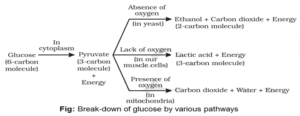
This step happens in the cytoplasm. Glucose molecule is broken down into pyruvic acid. Glucose molecule is composed of 6 carbon atoms, while pyruvic acid is composed of 3 carbon atoms.
(b) Fate of Pyruvic Acid:
Further breaking down of pyruvic acid takes place in mitochondria and the molecules formed depend on the type of respiration in a particular organism. Respiration is of two types, viz. aerobic respiration and anaerobic respiration.
BREAKDOWN OF GLUCOSE BY VARIOUS PATHWAY
STORAGE OF ENERGY DURING RESPIRATION
- The energy released during respiration is used to make ATP molecules from ADP molecules and inorganic phosphate.
ADP + Phosphate + Energy ———-> ATP
ADP: Adenosine di-phosphate
ADP: Adenosine tri-phosphate
- When cells need energy then these ATP molecule further converted into ADP molecules, phosphate and energy.
ATP ——-> ADP + Phosphate + Energy
TYPES OF RESPIRATION
There are two types of respiration. They are aerobic respiration and anaerobic respiration.
(a)AEROBIC RESPIRATION
- The respiration takes place in the presence of oxygen is called aerobic respiration.
- In aerobic respiration, glucose is converted into pyruvate in cytoplasm and then in the presence of oxygen pyruvate is converted into CO2 , Water and energy.
Glycolysis in the presence of O2
Glucose ————> Pyruvate —————————–> CO2 + Water + Energy
cytoplasm mitochondria
(b)ANAEROBIC RESPIRATION
- The respiration takes place in the absence (or deficiency)of oxygen is called anaerobic respiration.
- In anaerobic respiration, glucose is converted into pyruvate in cytoplasm and then in the absence of oxygen pyruvate is converted in
- Ethanol, CO2 and energy in Yeast.
- Lactic Acid and Energy in Muscle cells
RESPIRATION IN PLANTS
In plants respiration takes place through various parts of the plants.
(a)RESPIRATION IN LEAVES : In leaves respiration takes place through stomata.
(b)RESPIRATION IN STEM: Herbaceous plants stem respire through stomata and woody plants respire through lenticels.
(c)RESPIRATION IN ROOTS: As we know air is present in between the particles of the soil. The roots of the plants takes the oxygen from the air present between these soil particles by the process diffusion.
In plants respiration in the leaves takes place during the day time as well as night
- During day time oxygen is produced by the process photosynthesis. Some of the oxygen produced is used in respiration and rest of the oxygen is diffuses into atmosphere by the process diffusion. Also the CO2 produced by respiration is used in photosynthesis.
- At night time, when no photosynthesis takes place, plants use oxygen present in atmosphere for respiration and release considerable amount of CO2 in atmosphere.
Q: why land plants die if their root remain in water for a considerable time period?
Ans: The land plants die if their root remain in water for a considerable time because to much water expel all the air in between the soil particles. Due to this O2 is not available to the root for aerobic respiration. Under this condition, the roots will respire anaerobically alcohol which may kill the plant.
RESPIRATION IN AMOEBA
Amoeba is unicellular organism. It respire through simple diffusion of gases for breathing.
RESPIRATION IN AQUATIC ANIMALS
The aquatic animals have a special organ for breathing called Gills. They extract dissolved oxygen in water and use it for respiration.
RESPIRATION IN INSECTS
Insects like cockroach, housefly, mosquitoes have tiny holes called spiracles for respiration.
RESPIRATION IN EARTHWORM
Earthworm absorbs oxygen needed for respiration through its moist skin.
RESPIRATION IN HUMAN BEING
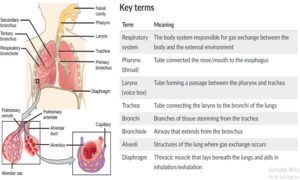
HUMAN RESPIRATORY SYSTEM
The process of physiological respiration includes two major parts: external respiration and internal respiration.
- External respiration, also known as breathing, involves both bringing air into the lungs (inhalation) and releasing air to the atmosphere (exhalation).
- During internal respiration, oxygen and carbon dioxide are exchanged between the cells and blood vessels.
Respiration begins at the nose or mouth, where oxygenated air is brought in before moving down the pharynx, larynx, and the trachea. The trachea branches into two bronchi, each leading into a lung. Each bronchus divides into smaller bronchi, and again into even smaller tubes called bronchioles. At the end of the bronchioles are air sacs called alveoli, and this is where gas exchange occurs.
Q: what are the feature of respiratory system?
Ans: All the respiratory organs whether it is gills lungs or trachea must have the following features:
- All the respiratory system have large surface area to get enough O2 for respiration.
- .All the respiration have thin walls for the easy exchange of respiratory gases.
- All the respiratory organs have rich blood supply for transporting respiratory gases.
BREATHING
The process of inhale oxygen and exhale carbon dioxide is called breathing.
PROCESS OF BREATHING
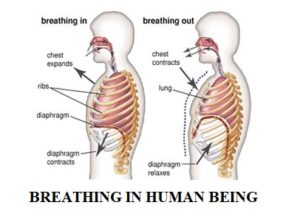
1. When we breath in air, the muscle of diaphragm contract and moves downward and the chest cavity and expands and air enter into the lungs.
2. When we breath out air, the muscles of diaphragm relax and moves upwards. The chest cavity contracts and air goes out of the lungs.
TRANSPORTATION
The main transport system in human being is a circulatory system. It consist of blood, arteries, veins, capillaries and heart.
1. BLOOD: Blood help in the transportation of food, water, Carbon dioxide, nitrogen and waste. It consist of Plasma, RBC’s , WBC’s and platelet.
- Plasma: It transports food, water, CO2, nitrogen and waste.
- RBC’s: It transport Oxygen.
- WBC’s: It kills the harmful bacteria and fight against the disease.
- Platelet: It help in clotting of blood and prevent loss of blood during injury
2. ARTERIES:Arteries carry pure blood (oxygenated blood) from heart to the all body parts. They are thick walled and do not have valves.
3. VEINS: Arteries carry impure blood (deoxygenated blood) all body parts. They are thin walled and have valves.
4. CAPILLARIES: These are very narrow blood vessel which connect arteries and veins together. The exchange of food, water, oxygen, CO2 etc takes place through capillaries.
HEART
Heart is a muscular organ which pumps blood to all parts of the body.

Structure of human heart
STRUCTURE OF HUMAN HEART
- Our heart has four chambers. Upper two chambers are called atria and the lower two chambers are called ventricles.
- Since Ventricles pump blood to different organs under high pressure. Therefore , their walls are thicker than atria.
- The right and left chambers are separated by Septum. It prevent the mixing of oxygenated(pure) and deoxygenated(impure) blood.
- The atria and ventricles have valves between them to prevent backward flow of blood.
WORKING OF HEART
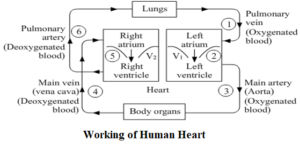
The working of heart can be explained in the following steps.
- When all the four chambers are relaxed, the pulmonary vein brings blood from lungs to left atrium of the heart.
- When the left atrium contract, the oxygenated blood pushes into the left ventricle.
- When the left ventricle contract, the oxygenated blood pushes from left ventricle to all body organs through main artery.
- Now the main vein carry deoxygenated blood from all body organs to the right atrium of the heart.
- When right atrium contract, the blood pushes from right atrium to right ventricle.
- When right ventricle contract, the deoxygenated blood move from right ventricle to the lungs through pulmonary artery.
In this way blood twice through the heart in on circulation, therefore it is known as double circulation.
Q: Write a short note on the following:
- Carbon mono oxide poisoning.
- Hemoglobin
- Ventilator
1. CARBON MONOXIDE POISONING
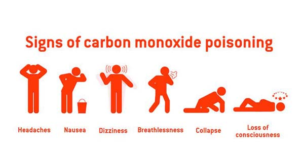
Carbon monoxide is a poisonous gas it is formed by the incomplete combustion of fuel. We know that hemoglobin present in blood carry oxygen to all body parts. Hemoglobin has more affinity for carbon monoxide than oxygen so it strongly bind with hemoglobin and prevent the transportation of oxygen to brain and other body part. Due to lack of oxygen, the person can not breath properly and if carbon monoxide is inhaled for long time then the person may become unconscious and it may leads to the death of the person.
2.HEMOGLOBIN
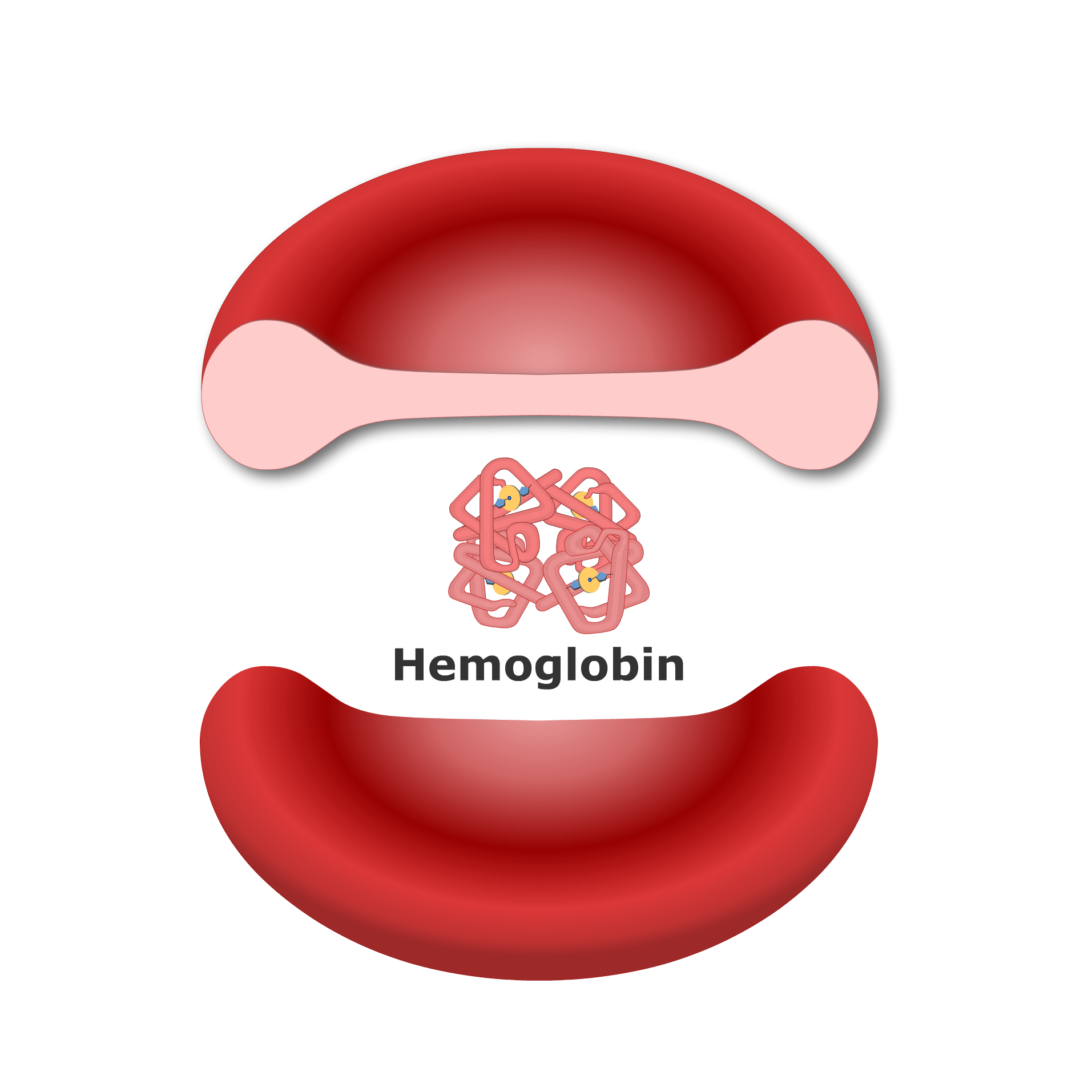
Hemoglobin is a pigment present in our blood. The normal range of hemoglobin in the blood of an healthy adult person is 12-18 gm/dl of blood. The deficiency of the hemoglobin in the blood of a person reduces the oxygen carrying capacity of blood which may leads breathing problems, tiredness and lack of energy. In the deficiency of hemoglobin the person may also look pale(yellowish) and can loose weight. This condition is called anemia and the person is called anemic.
3.VENTILATOR

The person having breathing problems are given O2 masks to facilitate breathing. In serious cases , the patient is put on a machine called ventilator in which a tube carrying oxygen is inserted directly into the trachea of patient to help him breath comfortably.
HEART BEAT
The heart pumps blood into our arteries by contracting and when heart relaxes it get filled with blood. “One contraction and relaxation of the heart is called heart beat”. It is about 72 beats per minute for a normal person.
BLOOD PRESSURE
The pressure at which blood is pumped around the body by the heart is called blood pressure. It is expressed in the form of two values known as Systolic and diastolic.
1.Systolic Pressure: The maximum pressure at which the blood leaves the heart. Through the main artery during contraction phase is called systolic pressure. The normal systolic pressure is 120mmHg.
2.Diastolic Pressure: The minimum blood pressure in the arteries during the relaxation phase of heart is called diastolic pressure. The normal diastolic pressure is 80mmHg.
NOTE:
If a person has B.P 110/75 then it called law blood pressure or hypotension.
NOTE:
If a person has B.P 145/90 then it is called high blood pressure or hyper tension.
Q: How can blood pressured be measured?
Ans: The blood pressure can be measured by using a device known as Blood Pressure Machine. It consist of three components.
(i) Stethoscope
(ii) Pumping device
(iii) Rubber Cuff
The doctor ties the rubber cuff about the branchial artery and put the stethoscope in his ears to hear the heart beat. Now he will increase the reading of mercury to 220mmHg by pumping device and leave it until the tapping voice is heard. As soon as the tapping voice is heard, he measured the reading and mercury level will continuously slow down and tapping voice is slowly disappear and the moment at which tapping voice disappear, reading is measured.
These two readings will tell that the person has hypertension, hypotension or a normal B.P.
LYMPH
Lymph is a light yellow coloured liquid which is somewhat similar to plasma. As we know blood flows in blood vessels, blood vessels are porous in nature, From these pores plasma, WBC’s and small protein seep out and form a liquid is called Lymph. The vessels through which lymph flows are called lymph vessels or lymph nodes.
FUNCTIONS OF LYMPH
- Lymph takes part in the nutritive part of the body.
- It protect the body by killing the germs.
- It helps in removing the waste products.
TRANSPORTATION IN PLANTS
Transportation in plants is less elaborated than in animals. Plants are less active than animals, so their cells do not need material so quickly. Also due to branching shape of the plants, all the parts of the plants can get O2 for respiration and CO2 for photosynthesis directly from the air by the process diffusion.
Therefore, Only the substances which are to be supplied through transportation system are water, minerals and food.
The plants have two transport system. They are Xylem and Phloem.
XYLEM
Xylem is a conductive tissue and is responsible to transport water and minerals from roots to leave.Xylem is composed of four components-
- Xylem vessels(dead)
- Tracheid’s(dead)
- Xylem parenchyma(living)
- Xylem Fibers(dead)
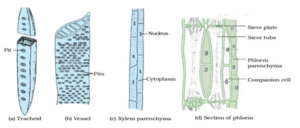
1. XYLEM VESSELS: Xylem vessels are long tube like structures in which cells are placed end to end. Vessels are open ended and are responsible to transport water and minerals.
2. XYLEM TRACHEIDS :Tracheid’s are spindle shaped cells. They do not have open ends like vessels, so they pass water and minerals through pits(pits are non lignified area).
3.XYLEM PARENCHYMA: Xylem Parenchyma is a living part of the xylem and is responsible for storage of food.
4.XYLEM FIBRES: Xylem fibres have dead cells and are responsible to provide mechanical support to the plants.
NOTE: Except xylem parenchyma, all the other components of xylem are dead.
Q: How water is sucked up by xylem vessels?
Ans: Water moves up in xylem vessels in the same way that a cold drink moves up in a Straw. When we suck the straw, we reduce the air pressure at the top of the straw due to which cold drink moves upward. In the same way, in xylem, pressure at the top remain law due to transpiration. Therefore ,water moves in upward direction.
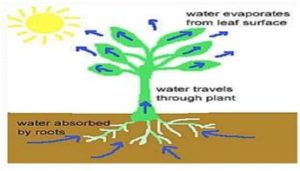
PHLOEM
Phloem is a conductive tissue and is responsible to transport food from leaves to all parts of the plant. This process is known as translocation. It consist of four components.
1. Sieve tubes
2. Companion cells
3. Phloem parenchyma
4. Phloem fibre
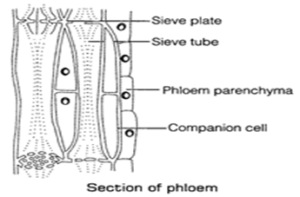
1. SIEVE TUBE: They are tube like structure in which cells are connected end to end. The end wall of sieve tube is called sieve plate which have small holes. These small holes allow food to pass through the sieve tube. Sieve tubes have cytoplasm but no nucleus.
2. COMPANION CELLS: Each sieve tube has a companion cell next to it. These companion cells have a nucleus and many other organelles. Companion cells help sieve tube in the transportation of food.
3. PHLOEM PARENCHYMA : It is responsible for the storage of food.
4. PHLOEM FIBRE: They are thread like structures made up of dead cells and are responsible to provide mechanical support to the plants.
EXCRETION
Excretion is the process by which the waste products produced during metabolic activities are removed from the body.
- In unicellular organisms(like amoeba), the waste products are removed from the cells into the surrounding by the process diffusion.
- In Multicellular organisms, the waste products are removed through specialized organs
EXCRETION IN HUMAN BEINGS
Human beings have three excretory organs. They are
- LUNGS for the excretion of CO2.
- SKIN for the excretion of Water and Salt.
- KIDNEY for the excretion of Urea.
EXCRETORY SYSTEM OF HUMAN BEINGS
The excretory system consist of a pair of kidneys, a pair of ureters, urinary bladder and urethra. Each kidney has a number of excretory units called nephrons.
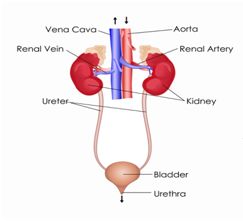
1.KIDNEY: The excretory system of human beings consist of a pair of kidney, Kidneys are responsible to remove unwanted substances like urea, salt waste etc from our blood and excrete these waste in the form of yellowish liquid called Urine.
2. URETERS:The excretory system of human being consist of a pair of ureters, one from each kidney. Ureters are responsible to carry urine from Kidney to urinary bladder.
3. URINARY BLADDER: Urinary bladder is a bag like structure which store urine till we go to toilet.
4.URETHRA: Urethra is a body organ which excrete the urine present in the Urinary bladder.
NEPHRONE
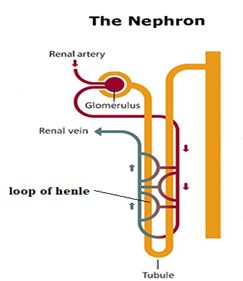
A kidney is made up of a number of excretory unit called Nephron has a cup shaped bag at its upper end which is called bowman’s capsule. The lower end of Bowman’s capsule. The lower end of the bowman capsule is tube shaped structure which is called tubule. The bowman’s capsule and a tubule together make Nephron.
A bowman’s capsule contain a bundle of capillaries which are called Glomerulus. Glomerulus is responsible to filter the blood.
EXCRETION IN PLANTS
Like animals, plants also produce a number of wastes products. As compared to animals the plants produce waste very slowly and in very small amount. The various methods used by plants to get-rid of their waste products are as follow:
- Plants get-rid of gaseous waste products through stomata in leaves and lenticels in stems.
- The plants get-rid of excess of water by the process transpiration.
- The plants get-rid of solid waste products by shedding their leaves or by falling fruit.
- Some plants secretes their waste in the form of gum.